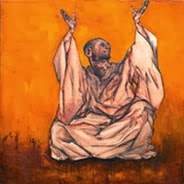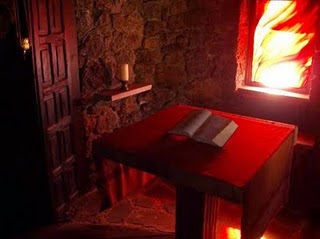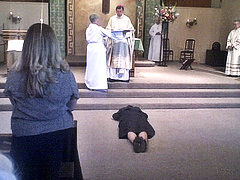 Dear Sister, you write a lot about temporal things, laws, requirements, the contents of a lay hermit's prayer space, habits, titles, and things like that. One blogger has opined that hermits grow beyond such concerns as they become more spiritual. She wrote recently: "How long did this hermit remain more or less in place, discussing or thinking about--or maybe thinking it had the responsibility to write about temporal matters such as what does a hermit wear, or eat, or daily routine, or title, or rule of life or what prayers, or what degree of solitude, and what does its hermitage look like? . . .Do we outgrow, or should we outgrow, the temporal aspects of our lives as we progress in life, and spiral more upward--or deeper in--and seek the spiritual aspects that our souls truly desire and actually need?"
Dear Sister, you write a lot about temporal things, laws, requirements, the contents of a lay hermit's prayer space, habits, titles, and things like that. One blogger has opined that hermits grow beyond such concerns as they become more spiritual. She wrote recently: "How long did this hermit remain more or less in place, discussing or thinking about--or maybe thinking it had the responsibility to write about temporal matters such as what does a hermit wear, or eat, or daily routine, or title, or rule of life or what prayers, or what degree of solitude, and what does its hermitage look like? . . .Do we outgrow, or should we outgrow, the temporal aspects of our lives as we progress in life, and spiral more upward--or deeper in--and seek the spiritual aspects that our souls truly desire and actually need?"
Before I ask my questions I wanted to say I am grateful to you for your blog. I think it is probably helpful to people considering becoming hermits and for those of us with questions about spirituality generally. I also love that you share things like what gives you pleasure or post videos of your orchestra. Those posts reveal a lot about yourself and I personally enjoy that. My question is whether you see yourself growing out of a concern with temporal things or writing about these things? The other blogger thought these reflected a newly-wed stage of life; she also suggested that the concern with the temporal had a link with the US as opposed to other countries. I guess her blog readers come more from other countries and are not as interested in some of the questions you deal with. I don't see how she could know what countries your questions come from though.]]
 Thanks very much for your comments and questions. No one ever asked me about what gives me pleasure before; I am sure at least some think there is nothing edifying about the experience of pleasure! As though the mere experience of pleasure implies one is a hedonist! Others have asked me to say more about my everyday life but I have not been able to do that; these questions seemed sort of invasive and also were a little hard to imagine what to say. Anyway, I enjoyed that question and I hope one of the things it indicates is the profound happiness associated with this vocation. Every aspect of it can be a source of real joy and yes, "pleasure" or gratification because it all reflects life with God and the quality of that. To some extent that anticipates your questions!.
Thanks very much for your comments and questions. No one ever asked me about what gives me pleasure before; I am sure at least some think there is nothing edifying about the experience of pleasure! As though the mere experience of pleasure implies one is a hedonist! Others have asked me to say more about my everyday life but I have not been able to do that; these questions seemed sort of invasive and also were a little hard to imagine what to say. Anyway, I enjoyed that question and I hope one of the things it indicates is the profound happiness associated with this vocation. Every aspect of it can be a source of real joy and yes, "pleasure" or gratification because it all reflects life with God and the quality of that. To some extent that anticipates your questions!.
I may have told this story before, but I was once working with a hermit candidate in another diocese and he asked me how I balanced "hermit things" and "worldly things" in my life. When I asked him what he meant by worldly things he listed things like grocery shopping, doing the dishes and laundry, scrubbing floors, cleaning the bathroom and things like that. When I asked about "hermit things" he referred to prayer, lectio divina, Office, Mass, and things like that. In other words, he had divided the world neatly into two classes of things, one having to do with what most folks call "worldly" or "temporal" and those most folks refer to as "spiritual" or "eternal." What I had to try and make clear to this candidate was that to the extent he really was a hermit, everything he did every day were hermit things, everything he did or was called to do was to be an expression of the eternal life he shared in by virtue of his baptism and new life in Christ. A neat division into spiritual and temporal simply doesn't work with our God. The incarnation rules that out.
Instead we belong to a Sacramental world in which the most ordinary and ephemeral can become the mediator of the divinely extraordinary and eternal. We see this every day in our own worship as wine wheat, water, oil, and wax among other things mediate the life and light of God to us. Even more, we belong to a world which heaven has begun to interpenetrate completely. It is a world in which God is meant to be all in all, a world which itself is meant to exist in and through God alone. This involves God revealing (Him)self in the unexpected and even the unacceptable place --- transforming (hallowing) them utterly with his presence. The descent and self emptying of God in creation and the incarnation is balanced or completed by the Ascension of the Risen Jesus into the very life of God. As we heard earlier this week, Christ goes to God to prepare a place for us, a place for the human and "temporal" in the very life of God (Him)self.
It is the place of disciples of Christ to proclaim the way the event of Jesus' life, death, and resurrection has changed our world and our destiny. Christians recognize that every part of our world and our lives can glorify God. That is, every part of our world and lives can reveal God to others. So, you see, I think the simplistic division of reality into temporal and spiritual is actually anti-Christian and I have said this in the past. I don't, therefore, think we outgrow our concern with the temporal dimensions of our lives. Instead, unless we refuse to allow this to occur through our all-too-human ways of seeing and thinking, they come more and more to reflect the presence of God and are consecrated or made holy by that presence and our awareness of it. Because my own vocation is a public one I feel a responsibility to share about elements of that vocation which people raise questions about. Moreover, many of the questions I have dealt with recently are related to becoming a hermit, discerning the distinction between legitimate hermits and counterfeits, fielding concerns about distortions in spirituality which can be harmful to people, etc. I think these are important.
 Especially these questions lead to or are part of important discussions of truthfulness, personal integrity, pretense, shame, the dialogical and ecclesial nature of the eremitical vocation, the capacity of one's relationship with God to transform the deficiencies of her life into actual gifts, the nature of symbols, our faith as essentially Sacramental, the universal call to holiness and the sanctity of ALL vocations, the importance of lay eremitical life as well as of canonical or consecrated eremitical life, ministerial vs contemplative vocations, and any number of other topics. What may seem to be superficial matters, matters far removed from the "spiritual" or "eternal" tend from my perspective as a theologian, a contemplative, and a Benedictine to open unto far deeper issues. This is because they are part of an organic whole where the whole is essentially sacramental.
Especially these questions lead to or are part of important discussions of truthfulness, personal integrity, pretense, shame, the dialogical and ecclesial nature of the eremitical vocation, the capacity of one's relationship with God to transform the deficiencies of her life into actual gifts, the nature of symbols, our faith as essentially Sacramental, the universal call to holiness and the sanctity of ALL vocations, the importance of lay eremitical life as well as of canonical or consecrated eremitical life, ministerial vs contemplative vocations, and any number of other topics. What may seem to be superficial matters, matters far removed from the "spiritual" or "eternal" tend from my perspective as a theologian, a contemplative, and a Benedictine to open unto far deeper issues. This is because they are part of an organic whole where the whole is essentially sacramental.
However, there is another perspective which I should mention. The blogger you are citing is a privately dedicated lay hermit. She is certainly called to be responsible for her vocation but not in quite the same way I am for mine. She does not share the same rights (title, habit, publicly ecclesial eremitical life) nor is she publicly responsible for things like the quality of her rule, the importance and nature of a horarium, the place of legitimate superiors and the nature of obedience, the degrees and types of solitude one is called to embrace, degrees and kinds of work allowed, forms of prayer advised, approaches to penance, the charism of the life, etc. Because of this she may not see these things or their depth and significance in the same way I do. That is hardly surprising.
Of course this blogger has every right to disagree, to weigh in on issues and give her own perspective on them, especially if she does so honestly as a woman living a privately dedicated lay eremitical life rather than a "consecrated Catholic Hermit" or "professed religious". If she so chooses she is completely free to speak only of the things she considers spiritual matters and leave all those other things up to those for whom they are more meaningful and part of a deeply incarnational spiritual life and perspective. What she is less free to do is speak with impunity about canon 603, its nature and associated rights and obligations as though she is as knowledgeable about such things as someone living them. When she does this she opens herself to discussion, debate and even correction by those (canonists, hermits, historians, theologians) who are both more experienced and more knowledgeable than she is. Granted, some of what she seems to be dismissing as "temporal" rather than "eternal," for instance are certainly things an experienced hermit does not worry about and she is correct that some of them (like habits and titles) are usually of more concern to beginners or "wannabes".
However, they are also matters which point beyond themselves to the ecclesial nature and dimension of the vocation; thus some canonical hermits honor these with their lives. Other matters are never superficial. The hermit's Rule, will help the Church hierarchy to discern vocations to the eremitical life under canon 603 while the task of writing one can aid in a hermit's formation as well as her diocese's discernment of her readiness for temporary or perpetual profession. Beyond profession it will be part of governing and inspiring her life day in and day out for the remainder of her life. She will live in dialogue with it and with God through it so long as she lives. My own Rule is something I make notes in, reflect on, and revise as my own understanding grows and life circumstances change. Among other things it helps me to discern the wisdom of increased active ministry or greater reclusion, review the overall shape of my life, reflects the nature of my prayer and growth in this, and can even reflect the quality of my physical health and call attention to problems I might not be aware of otherwise.
Another matter which is never merely superficial is the way a hermitage or one's prayer space looks. Here appearance and function are profoundly related. Canonical hermits are publicly responsible for simple lives of religious poverty, obedience and celibate love in the silence of solitude. God is the center of their lives and their living space should reflect all of these things. What is as important --- since few people will actually come into hermit's living or prayer space --- is that a hermitage with too much "stuff" can be an obstacle to the life a hermit is called to live. I have been doing Spring cleaning off and on these past two weeks or so and that means getting rid of the accumulation of a year and more. This accumulation occurs partly because I don't drive and cannot simply take stuff to used book stores, thrift stores, the salvation Army, etc. Papers and books especially accumulate. Once the "stuff" is gone, even though the place was neat anyway, the feeling is simply much different. I personally feel lighter, happier, more able to "breathe", work and pray.
The simple fact is that in our incarnational faith concern for and engagement with the temporal is the means by which we are engaged with the Eternal and the ordinary way the Eternal is mediated to us. Resurrected life is Bodily existence and though we can hardly imagine what this means we must continue to hold these two things together in our understanding just as we hold the temporal and the spiritual together in our appreciation of reality as sacramental.










































.jpg)























